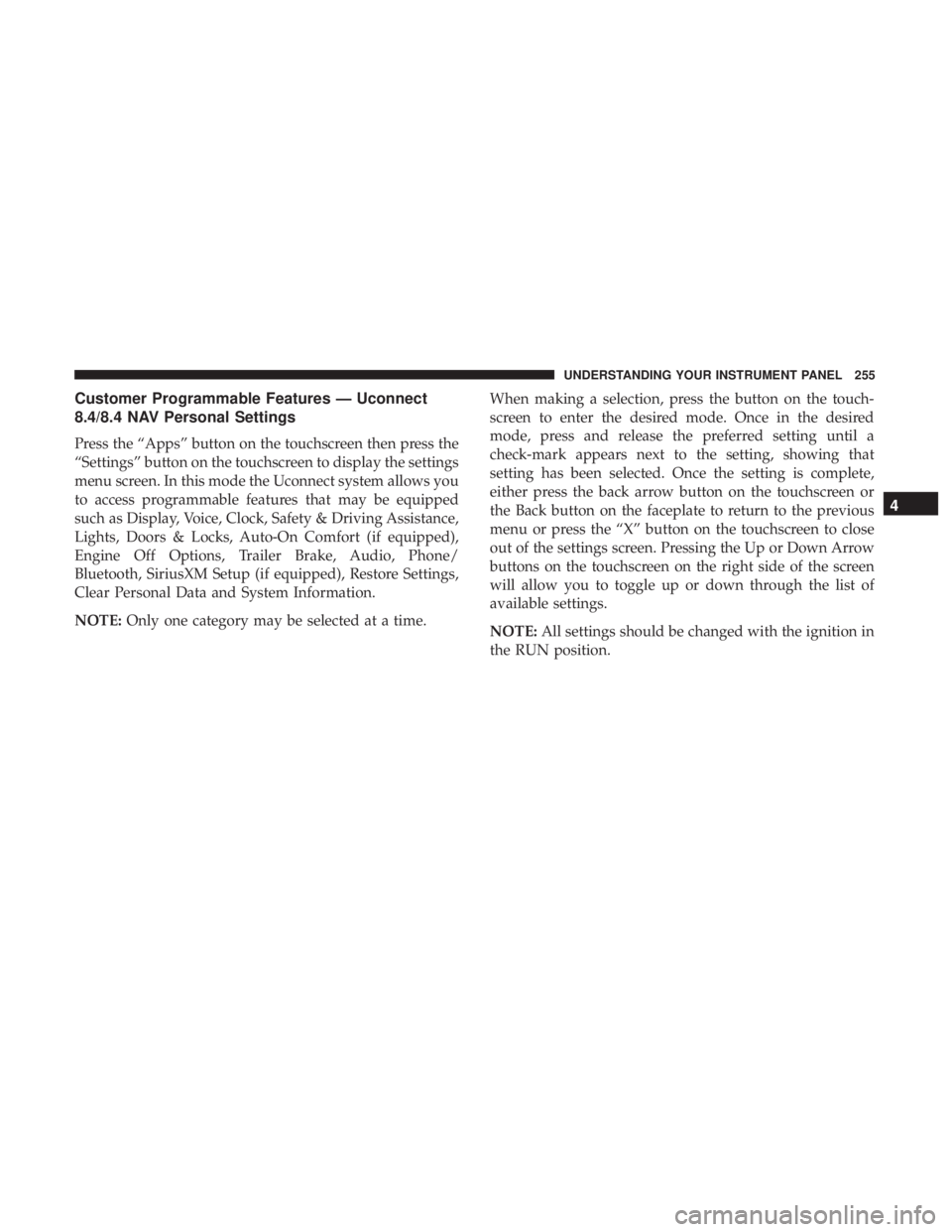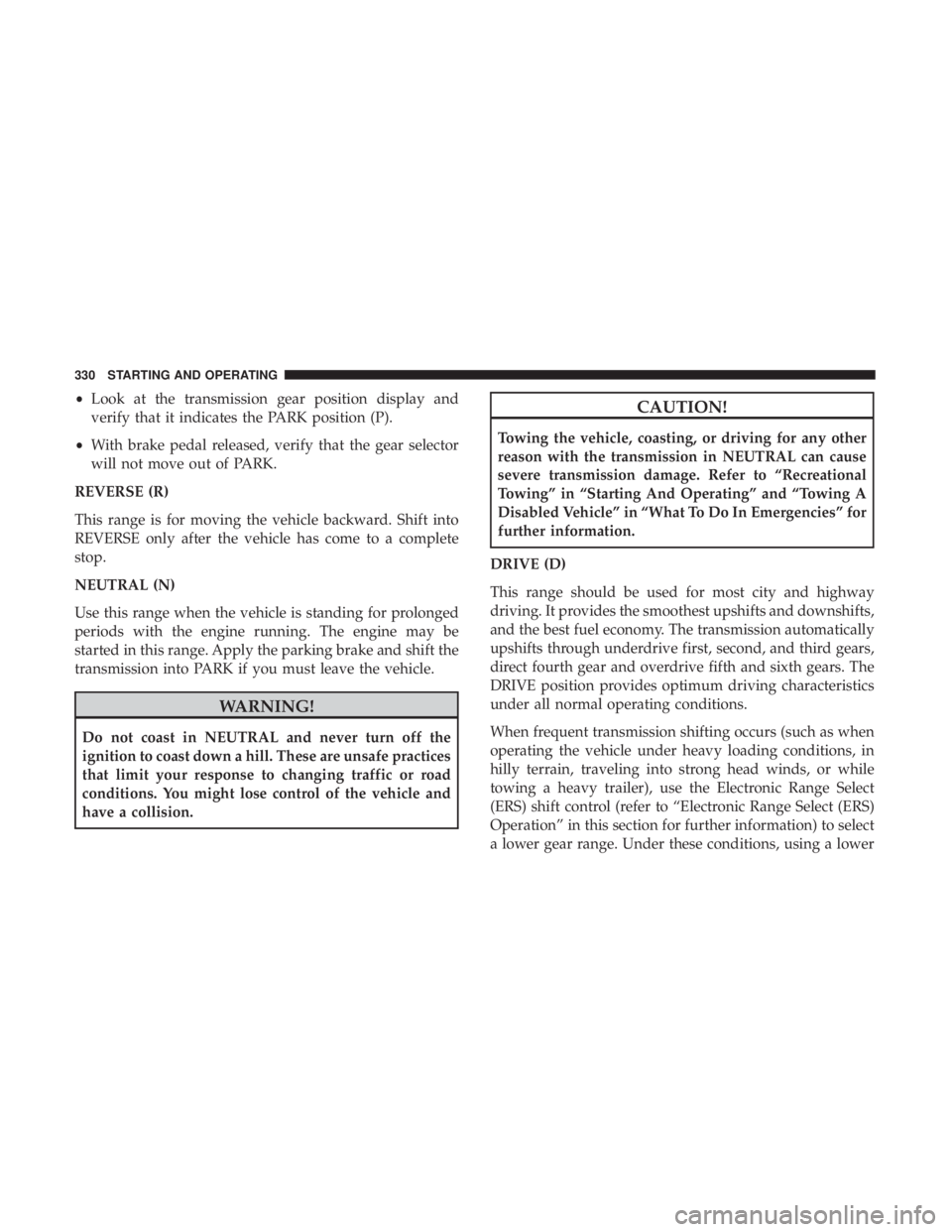Page 249 of 536
Engine Off Options
After pressing the “Engine Off Options” button on the
touchscreen, the following settings will be available:
Setting Name Selectable Options
Easy Exit Seats —
If Equipped
Headlight Off Delay 0 sec 30 sec 60 sec 90 sec
Engine Off Power
Delay 0 sec 45 sec 5 min 10 min
Trailer Brake
After pressing the “Trailer Brake” button on the touch-
screen, the following settings will be available:
Setting Name Selectable Options
Trailer Select Trailer 1 Trailer 2 Trailer 3 Trailer 4
Trailer Brake Type Light Electric Heavy Electric Light EOH Heavy EOH 4UNDERSTANDING YOUR INSTRUMENT PANEL 247
Page 257 of 536

Customer Programmable Features — Uconnect
8.4/8.4 NAV Personal Settings
Press the “Apps” button on the touchscreen then press the
“Settings” button on the touchscreen to display the settings
menu screen. In this mode the Uconnect system allows you
to access programmable features that may be equipped
such as Display, Voice, Clock, Safety & Driving Assistance,
Lights, Doors & Locks, Auto-On Comfort (if equipped),
Engine Off Options, Trailer Brake, Audio, Phone/
Bluetooth, SiriusXM Setup (if equipped), Restore Settings,
Clear Personal Data and System Information.
NOTE: Only one category may be selected at a time. When making a selection, press the button on the touch-
screen to enter the desired mode. Once in the desired
mode, press and release the preferred setting until a
check-mark appears next to the setting, showing that
setting has been selected. Once the setting is complete,
either press the back arrow button on the touchscreen or
the Back button on the faceplate to return to the previous
menu or press the “X” button on the touchscreen to close
out of the settings screen. Pressing the Up or Down Arrow
buttons on the touchscreen on the right side of the screen
will allow you to toggle up or down through the list of
available settings.
NOTE: All settings should be changed with the ignition in
the RUN position. 4UNDERSTANDING YOUR INSTRUMENT PANEL 255
Page 269 of 536

Engine Off Options
After pressing the “Engine Off Options” button on the
touchscreen, the following settings will be available:
Setting Name Selectable Options
Engine Off Power Delay +–
NOTE: When the “Engine Off Power Delay” feature is selected, the power window switches, radio, Uconnect phone
system (if equipped), DVD video system (if equipped), power sunroof (if equipped), and power outlets will remain
active for up to 10 minutes after the ignition is cycled to OFF. Opening either front door will cancel this feature.
Headlight Off Delay +“ –
NOTE: When the “Headlight Off Delay” feature is selected, the driver can choose to have the headlights remain on
for 0, 30, 60, or 90 seconds when exiting the vehicle.
Trailer Brake
After pressing the “Trailer Brake” button on the touch-
screen, the following settings will be available:
Setting Name Selectable Options
Trailer Select Trailer 1 Trailer 2 Trailer 3 Trailer 4
Trailer Brake Type Light Electric Heavy Electric Light EOH Heavy EOH 4UNDERSTANDING YOUR INSTRUMENT PANEL 267
Page 320 of 536

▫ Shallow Standing Water ................. .348
� POWER STEERING ..................... .349
▫ Power Steering Fluid Check .............. .350
� PARKING BRAKE ...................... .350
� BRAKE SYSTEM ....................... .352
▫ Hydraulic Brake Assist .................. .352
� ELECTRONIC BRAKE CONTROL SYSTEM .... .353
▫ Electronic Brake Force Distribution (EBD) ..... .353
▫ Brake System Warning Light .............. .353
▫ Anti-Lock Brake System (ABS) ............ .353
▫ Anti-Lock Brake Warning Light ............ .354
▫ Brake Assist System (BAS) ............... .355
▫ Hill Start Assist (HSA) .................. .355
▫ Traction Control System (TCS) ............ .358
▫ Electronic Stability Control (ESC) .......... .358
▫ Electronic Roll Mitigation (ERM) .......... .362
▫ Trailer Sway Control (TSC) — If Equipped . . . .362 ▫ Hill Descent Control (HDC) — If Equipped . . . .363
� TIRE SAFETY INFORMATION ............. .365
▫ Tire Markings ........................ .365
▫ Tire Identification Number (TIN) ........... .369
▫ Tire Terminology And Definitions .......... .370
▫ Tire Loading And Tire Pressure ........... .371
� TIRES — GENERAL INFORMATION ........ .376
▫ Tire Pressure ......................... .376
▫ Tire Inflation Pressures ................. .377
▫ T ir e Pressures For High Speed Operation .... .378
▫ Tire Maintenance And Replacement ......... .378
▫ Radial Ply Tires ....................... .378
▫ Tire Types ........................... .379
▫ Run Flat Tires — If Equipped ............. .380
▫ Spare Tires — If Equipped ............... .380
▫ Tire Spinning ........................ .382
▫ Tread Wear Indicators .................. .383318 STARTING AND OPERATING
Page 321 of 536

▫ Life Of Tire .......................... .383
▫ Replacement Tires ..................... .384
� TIRE CHAINS (TRACTION DEVICES) ........ .385
� TIRE ROTATION RECOMMENDATIONS ..... .387
▫ Dual Rear Wheels ..................... .388
� DEPARTMENT OF TRANSPORTATION
UNIFORM TIRE QUALITY GRADES ......... .389
▫ Treadwear ........................... .389
▫ Traction Grades ....................... .389
▫ Temperature Grades .................... .390
� TIRE PRESSURE MONITOR SYSTEM (TPMS) . . .390
▫ Base System — If Equipped .............. .392
▫ Premium System ...................... .393
▫ Tire Pressure Information System (TPIS)
Chassis Cab — If Equipped ............... .395
▫ General Information .................... .396
� FUEL REQUIREMENTS .................. .397
▫ 6.4L Engine .......................... .397 ▫ Reformulated Gasoline ................. .397
▫ Gasoline/Oxygenate Blends .............. .397
▫ E-85 Usage In Non-Flex Fuel Vehicles ........ .398
▫ CNG And LP Fuel System Modifications ..... .398
▫ MMT In Gasoline ...................... .398
▫ Materials Added To Fuel ................ .399
▫ Fuel System Cautions ................... .399
▫ Carbon Monoxide Warnings .............. .400
� ADDING FUEL ........................ .400
▫ Loose Fuel Filler Cap Message ............ .401
� VEHICLE LOADING .................... .401
▫ Certification Label ..................... .401
� TRAILER TOWING ..................... .403
▫ Common Towing Definitions .............. .404
▫ Trailer Hitch Classification ............... .408
▫ Trailer Towing Weights
(Maximum Trailer Weight Ratings) ......... .4085STARTING AND OPERATING 319
Page 322 of 536
▫ Trailer And Tongue Weight .............. .408
▫ Towing Requirements .................. .409
▫ Towing Tips .......................... .415
� SNOWPLOW .......................... .416
▫ Before Plowing ....................... .416
▫ Snowplow Prep Package Model Availability . . . .417
▫ Over The Road Operation With Snowplow
Attached ............................ .417
▫ Operating Tips ........................ .418 ▫ General Maintenance ................... .418
� RECREATIONAL TOWING
(BEHIND MOTORHOME, ETC.) ............ .419
▫ Towing This Vehicle Behind Another Vehicle. . . .419
▫ Recreational Towing — Two-Wheel Drive
Models ............................. .420
▫ Recreational Towing — Four-Wheel Drive
Models ............................. .420320 STARTING AND OPERATING
Page 332 of 536

• Look at the transmission gear position display and
verify that it indicates the PARK position (P).
• With brake pedal released, verify that the gear selector
will not move out of PARK.
REVERSE (R)
This range is for moving the vehicle backward. Shift into
REVERSE only after the vehicle has come to a complete
stop.
NEUTRAL (N)
Use this range when the vehicle is standing for prolonged
periods with the engine running. The engine may be
started in this range. Apply the parking brake and shift the
transmission into PARK if you must leave the vehicle.
WARNING!Do not coast in NEUTRAL and never turn off the
ignition to coast down a hill. These are unsafe practices
that limit your response to changing traffic or road
conditions. You might lose control of the vehicle and
have a collision. CAUTION!Towing the vehicle, coasting, or driving for any other
reason with the transmission in NEUTRAL can cause
severe transmission damage. Refer to “Recreational
Towing” in “Starting And Operating” and “Towing A
Disabled Vehicle” in “What To Do In Emergencies” for
further information.
DRIVE (D)
This range should be used for most city and highway
driving. It provides the smoothest upshifts and downshifts,
and the best fuel economy. The transmission automatically
upshifts through underdrive first, second, and third gears,
direct fourth gear and overdrive fifth and sixth gears. The
DRIVE position provides optimum driving characteristics
under all normal operating conditions.
When frequent transmission shifting occurs (such as when
operating the vehicle under heavy loading conditions, in
hilly terrain, traveling into strong head winds, or while
towing a heavy trailer), use the Electronic Range Select
(ERS) shift control (refer to “Electronic Range Select (ERS)
Operation” in this section for further information) to select
a lower gear range. Under these conditions, using a lower330 STARTING AND OPERATING
Page 333 of 536

gear range will improve performance and extend transmis-
sion life by reducing excessive shifting and heat buildup.
If the transmission temperature exceeds normal operating
limits, the powertrain controller will modify the transmis-
sion shift schedule and expand the range of torque con-
verter clutch engagement. This is done to prevent trans-
mission damage due to overheating.
If the transmission becomes extremely hot or is in danger
of overheating, the “Transmission Temperature Warning
Light” may illuminate and the transmission may operate
differently until the transmission cools down.
NOTE: Use caution when operating a heavily loaded
vehicle at low speeds (such as towing a trailer up a steep
grade, or in stop-and-go traffic) during hot weather. In
these conditions, torque converter slip can impose a sig-
nificant additional heat load on the cooling system. Down-
shifting the transmission to the lowest possible gear (when
climbing a grade), or shifting to NEUTRAL (when stopped
in heavy traffic) can help to reduce this excess heat
generation. During cold temperatures, transmission operation may be
modified depending on engine and transmission tempera-
ture as well as vehicle speed. This feature improves warm
up time of the engine and transmission to achieve maxi-
mum efficiency. Engagement of the torque converter clutch
is inhibited until the transmission fluid is warm (refer to
the “Note” under “Torque Converter Clutch” in this sec-
tion).
On models with 66RFE transmission, top overdrive gear is
also inhibited until the transmission fluid is warm, and
during extremely cold temperatures (-16°F [-27°C] or be-
low), operation may briefly be limited to first and direct
gears only. On trucks with AS66RC transmission, fifth and
sixth gears may be inhibited briefly on cold starts below
41°F (5°C), and during very cold temperatures (-4°F [-20°C]
or below), operation may briefly be limited to third gear
only. During this condition, the ability of the vehicle to
accelerate under heavily loaded conditions may be re-
duced. In all cases, normal operation will resume once the
transmission temperature has risen to a suitable level. 5STARTING AND OPERATING 331